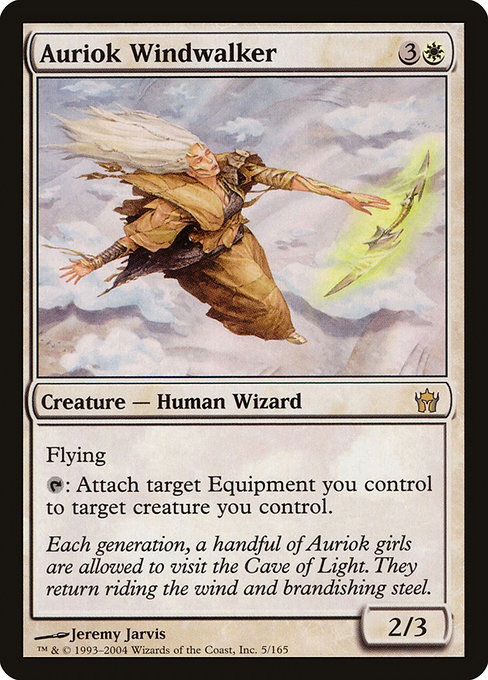
Image courtesy of Scryfall.com
Pivoting when this card is countered: strategy that keeps your plan alive 🧙♂️
In the grand tapestry of MTG, the moment your mightiest plan gets countered can feel like a sudden gust ripping the sails from your boat. But in a game built on tempo, angles, and a dash of luck, counterspells are not the end of the line—they’re just a turn or two of misdirection. When you’re piloting a white tempo creature with a knack for shuffling Equipment around, like the Fifth Dawn rare Auriok Windwalker, you don’t fold. You pivot. You adapt. You keep pressure while transitioning from “beatdown with wind and steel” to “win with resilience and clever resource management.” This article walks through a practical pivot strategy you can apply the moment your key plan is countered. 🔥⚔️
Auriok Windwalker at a glance
- Mana cost: {3}{W}
- Type: Creature — Human Wizard
- Rarity: Rare
- Set: Fifth Dawn (5dn), released 2004
- Abilities: Flying; {T}: Attach target Equipment you control to target creature you control.
- Power/Toughness: 2/3
- Flavor: "Each generation, a handful of Auriok girls are allowed to visit the Cave of Light. They return riding the wind and brandishing steel." — evocative lore that ties wind and steel into one elegant package. 🎨
Notice what makes Windwalker tick: itsFlying keyword gives you a tempo edge, and its tap ability offers flexible equipment shuffling. The spell economy is lean, the color is white, and the design leans into a classic MTG concept—turning a potential drawback (countered ability) into a doorway for alternate victory paths.
Why a countered resolution feels like a tempo dent
When your primary plan relies on resolving an activated ability to relocate equipment, a counterspell can stall or even derail your turn. The upside of this hiccup is that counterspells expose a window: your opponent has tapped, you’ve learned a little about their hand, and you get to adjust. The pivot is not about recapturing the exact same tempo; it’s about extracting value from the position you’re in and pressing a different line that still forces the opponent to answer you. 🧙♂️🔥
Plan B: concrete routes to keep the pressure going
- Shift to evasive, white-based beatdown: If Windwalker’s move to attach Equipment is blocked, lean on other flying creatures or evasive threats. A well-timed two-drop flier or a bigger winged threat can pressure opponents who expect Windwalker to anchor the attack. The key is to stack inevitability rather than a single-trigger win condition. 🪶
- Keep Equipment value alive with other enablers: Your deck can feature multiple ways to leverage Equipment even if Windwalker isn’t the one delivering the move. Think of other ETBs or two-card combos that empower Equipment-bearing creatures. Even if you can’t resolve Windwalker’s tap ability this turn, you can advance a parallel engine that keeps creatures dangerous and gear attached where it matters. 💎
- Pivot into a defensive tempo or value plan: White offers plenty of protection and stalling tools. A few well-chosen instants or auras can slow the board long enough for you to draw into a different piece of your strategy. Sometimes the best offense is a robust defense that morphs into a late-game win via card advantage or recurring threats. 🎲
- Reallocate your resources: If an attack plan stalls, switch to the long game—card draw, lifegain, or strategic removal. Maintaining a flexible mana curve and a couple of backup threats ensures you’re never out of a path to victory, even if the original plan fizzles. ⚔️
Sequencing tips: making a plan that survives counters
Sequencing becomes the real differentiator when you face counterspells. Keep a rough map in your head for both lines of play: your Windwalker-based tempo track and your backup plan. If you anticipate countering, you might want to deploy cheaper evasive threats early to pressure the opponent while you keep Windwalker in your back pocket for later, when the coast is clearer. Don’t overcommit; weigh your resources and aim for multi-threat lines that won’t crumble without the exact piece you hoped to resolve. And above all, stay flexible — magic rewards flexible minds. 🧠🎲
Lore, design, and the artistry of resilience
The Windwalker’s lore underscores a lineage of courage and blade-work; the Cave of Light and the Wind itself symbolize guidance under pressure. Jeremy Jarvis’ art captures that sense of motion and wind-blown determination, a fitting mirror for a creature whose best moment is often a player’s last-moment pivot. The card’s rarity as a rare in Fifth Dawn places it as a standout in a set famous for artifacts and auras—two themes that reward thoughtful play and a deep appreciation for how white control and tempo can intertwine with equipment-oriented strategies. Its cost—{3}{W}—asks for a modest mana investment, inviting gradual development rather than explosive immediacy. 🔥
Counterplay isn’t failure; it’s a prompt to improvise, adapt, and out-earn the tempo with a smarter plan. 🧙♂️
From a collector’s lens, Auriok Windwalker presents a snapshot of an era where white-based tempo and equipment synergy could converge into clever battlefield play. The card is a rare that appeared in a foil and non-foil print, with modest current market values that reflect its age and niche appeal. As a bridge between the flavor of wind-wrought steel and the practicalities of deck construction, Windwalker invites you to think beyond a single line of play and to embrace the rhythm of pivoting strategies. 💎
If you’re building or refreshing a white deck and want a tactile reminder of tomorrow’s plan, check out a product that keeps your game notes and style in sync—the neon cardholder phone case linked below. It’s a small but stylish carry for a big multiverse of games, and it pairs nicely with the ritual of reading card texts, plotting lines, and laughing at the surprises your opponents unleash. 🎨🎲